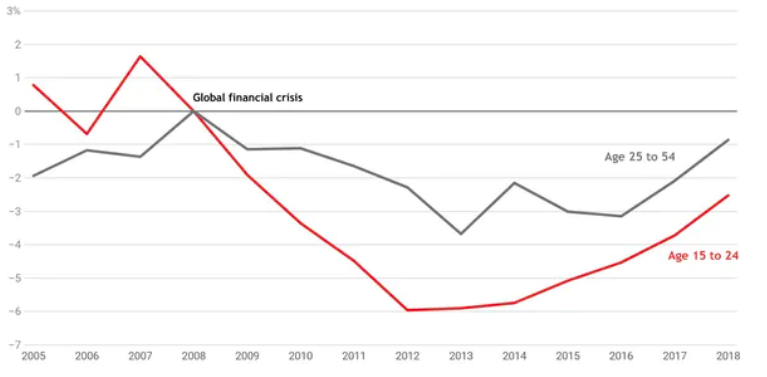
How many younger people are unemployed due to coronavirus?
Over 800,000 people in Australia have lost their jobs since the coronavirus pandemic began. While a breakdown of the number of people unemployed by age is not currently available, the Grattan Institute says younger people, or those aged 15-24, are disproportionately affected by the pandemic and will continue to be negatively affected into the future.
It is expected that one million young people will be unemployed in the UK by the end of the year. In China, one in six young people have found themselves jobless since the pandemic began, while in the US, 27.4% of those aged 16-24 are now unemployed.
On top of the struggles faced by those who were working in face-to-face environments, there is an even greater burden for workers who find themselves on casual contracts, because not all of them will receive support from the government’s JobKeeper scheme. Currently, 500,000 people who were working as casuals for less than 12 months are now unemployed and are not receiving JobKeeper payments.
Younger people are allowed to access their superannuation fund, however, this is being dubbed by some as irresponsible, as it could leave this group with $54,000-84,000 less in their retirement savings down the line.
According to the University of Melbourne, the younger demographic have been “crowded out” by those aged 25-54 since the global financial crisis. This means this age group is effectively working harder to get less; they have had to graft harder for less stable opportunities via unpaid internships and low pay.
The University of Melbourne comments are based on the fact that it took many years for the 25-54 year old age group to re-enter a period of stability, and even longer for the younger demographic to reach a period of growth.

Youth unemployment is likely to be a very real issue in the years of recovery after coronavirus because:
- The younger demographic is more likely to work in face-to-face environments, such as hospitality, retail trade and events
- The younger demographic is more likely to be employed on part-time or casual contracts, meaning the nature of their work could be less stable than their full-time peers
- The younger demographic is likely to have less experience than their older counterparts, who may also be likely to delay retirement in a bid to add extra security to their superannuation fund.
According to University of Melbourne economics professor, Jeff Borland, soon-to-be graduates are in danger of entering an unemployment cycle following graduation. Borland is calling for Higher Education Loan Scheme loans and access to free TAFE courses to ensure there is something on the other side for students.








Crikey is committed to hosting lively discussions. Help us keep the conversation useful, interesting and welcoming. We aim to publish comments quickly in the interest of promoting robust conversation, but we’re a small team and we deploy filters to protect against legal risk. Occasionally your comment may be held up while we review, but we’re working as fast as we can to keep the conversation rolling.
The Crikey comment section is members-only content. Please subscribe to leave a comment.
The Crikey comment section is members-only content. Please login to leave a comment.